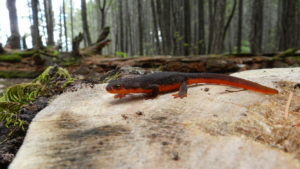 Some of you may have come across some interesting visitors in your wood piles this winter! Salamanders and newts are known for hiding away in decaying wood in the winter as they prepare for, mate, or lay eggs. Rough-skinned newts, in particular, are gregarious little fellows known for their orange bellies and rough skin. The skin is usually leathery with a granular or warty texture, but this becomes smoother in breeding males during the winter, when the tail enlarges and nuptial pads, used to grasp the female, appear on the toes.
Some of you may have come across some interesting visitors in your wood piles this winter! Salamanders and newts are known for hiding away in decaying wood in the winter as they prepare for, mate, or lay eggs. Rough-skinned newts, in particular, are gregarious little fellows known for their orange bellies and rough skin. The skin is usually leathery with a granular or warty texture, but this becomes smoother in breeding males during the winter, when the tail enlarges and nuptial pads, used to grasp the female, appear on the toes.
Their breeding season is from December through July, so they have plenty of time to find a place to hunker down for the winter. While they Prefer slow moving, quiet water, and can be found on land away from water under logs or rocks- they lay their eggs one at a time attached to underwater debris- sometimes migrating long distances to breeding ponds.
Rough-legged Newts can be yellow or tan, but are usually dark brown or black. Their underside is yellow, orange or red and they will display that bright colored underside when they’re threatened. They don’t need that bright underside though, as they are one of

Washington State’s most poisonous newts, and their toxins can cause mild skin irritation to humans who handle them- but severe symptoms if ingested, including paralysis and death. This toxin (tetrodotoxin) is secreted by both the eggs and the skin of adult newts. If you don’t believe us, check out this story about three hikers from the 60’s, all killed from a rough-skinned newt in their coffee pot.
Rough-skinned newts have been sighted often at the Refuge, in particular, Plankhouse docents and staff have come across them in both fire hearths.